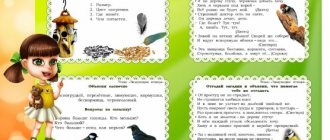Since ancient times, it was by objects of inanimate nature that people determined changes in the weather and its various phenomena: snow, rain, hurricane or blizzard.
Thanks to many years of observations of our ancestors over the world around us, today we have access to signs of inanimate nature about the weather, which help us predict accurate weather data for today, tomorrow, the next week or month.
Russian signs in the world of inanimate nature
Inanimate nature refers to the stars, sky, sun, earth and any natural phenomena, by observing which one can easily determine the weather for the near future.
Almost all folk signs about the weather in the world of inanimate nature were handed down to us by our ancestors who lived several centuries ago in Rus'.
Right now you can observe many interesting signs associated with natural phenomena:
- a blood-red dawn or sunrise warns of a decrease in air temperature and cloudy weather in the coming hours and days;
- a sharp change in wind strength (from hurricane to weak or vice versa) indicates a clear and cloudless day;
- non-blinding and slightly hazy rays of the sun mean the approach of a thunderstorm;
- the blue sky over the forest will please you with good news - warmth is near;
- good weather is also foreshadowed by high clouds ;
- the fog in the morning is light and spreads evenly - indicates warmth and lack of precipitation, and very thick fog warns of coolness and rain;
- frequent rains in the fall will continue into the spring, it will be just as wet;
- a dim, almost invisible moon in the night sky predicts rainy weather, and a bluish halo around it confirms this;
- snow that fell early in autumn - by early spring;
- exactly 40 days after the first snow, real winter will come;
- if the clouds are high , there is no need to worry, the weather will be good;
- two rainbows in the sky look impressive, but mean continuous rain.
Some signs in Russia have a scientific basis: “The thicker the shell of acorns, the harsher the winter” - proven by a scientist who described the relationship between shell hardening and winter frosts in the Farmer’s Almanac magazine.
Science also explains the increase in the thickness of onion and corn husks and the enlargement of pine cones before the upcoming cold weather, and much more.
Natural phenomena in summer
Inanimate nature
Inanimate nature at this time of year enjoys hot, dry weather. The sun is heating up strongly, the air temperature rises to maximum values. Rain and thunderstorms also occur, sometimes causing hail. After precipitation, you can often see a rainbow in the sky. Towards the morning, in calm weather, dew forms on the ground, plants and various objects located outside.
Live nature
Changes also occur in wildlife in the summer. The plants begin to actively flower and bear fruit. At the end of summer, the time for mushrooms and berries comes, and nuts ripen in the forests. Animals at this time of year raise their offspring, teach their cubs to get food for themselves and defend themselves in case of danger. Insects are very active in summer, some of them (mosquitoes, flies, midges and others) begin to annoy people. Dangerous arachnids, including poisonous spiders and encephalitis mites, are also activated.
Predictions for the solar system
To make an accurate weather forecast based on observations, it is better to compare several signs of objects or inanimate natural phenomena with each other. For example, if the sun sets into bright scarlet clouds, it will get colder the next day. And if there is also dense fog in the morning, it’s as if no warmth is expected. The more a person knows and accepts, the more accurate the forecast will be.
Lunar secrets
Looking at the outlines of the mysterious night luminary, you can determine what the coming day and the entire next week will be like:
- pale moonlight in winter indicates snowstorms and frosty days;
- a month floating across a foggy sky warns of snowstorms and serious snowfalls;
- a brightly shining moon means a sunny day and a change in air temperature;
- the summer moon, with unclear outlines, floating in the fog, marks bad weather and a period of rain.
Sun
The sun is warmth, energy, the beginning of a new life. Magicians consider a solar eclipse, of all natural phenomena, to be the most favorable moment for communication with the other world, and ordinary people determine weather conditions by the largest and hottest star:
- shining at sunset predicts a gusty and very powerful wind for the coming day;
- surrounded by fog - warns of heavy rain;
- peeking out after the rain promises a rich harvest of mushrooms;
- a halo around - indicates rain in summer, and snowfall in winter;
- red sunset - marks the wind throughout the next day;
- rose earlier than before - there will be rain.
What the stars are talking about
The night sky, strewn with billions of stars, cannot but fascinate. But glances are turned to him not only in romantic moments or moments of sadness, but also to determine the weather. It was thanks to these celestial bodies that travelers and sailors could predict weather conditions in advance, avoiding storms and storms that bring death to all living things. But it’s not only useful for them to know star signs:
- bright shining stars predict frost in winter, and heat in summer;
- strongly twinkling stars predicted bad weather, but at the same time, flickering in the early morning among the clouds is definitely a thunderstorm, and emerald midday stars lead to cloudless, dry weather;
- if the size of the stars seems smaller - it could be rain (or snow in winter);
- winter multi-stardom promises cold weather, summer – good weather, rare stardom – bad weather at any time of the year;
- dark circles around stars or nebula indicate slushy weather, while red or white ones predict heat;
- the darkened stars of the Big Dipper and dim stars of the Milky Way also warn about rain (light ones indicate clear weather);
- starfall signifies windiness;
- October bright stars indicate improved weather;
- the stars seem distant in summer - for rain, and in winter - for thaw;
- the night sky is clear, but no stars are visible - bad weather.
The reliability of the data has been repeatedly confirmed by observers, so they do not lose their relevance, helping to make accurate weather forecasts.
Other amazing natural phenomena
Unusual and sometimes mysterious natural phenomena sometimes occur in the world. Let's give examples of some of them.
Ball lightning
According to eyewitnesses, this rare phenomenon is a kind of luminous ball moving in the air along an unpredictable trajectory. In the scientific world there is still no consensus on what ball lightning is and how it occurs.
Northern lights
This phenomenon is characteristic not only of the Earth; it also occurs on other planets of the solar system that have a magnetosphere. People perceive it as a rapidly changing multi-colored glow in the sky at night. It is formed as a result of the interaction of the upper layers of the atmosphere with charged particles of the solar wind.
Snow storm
This unusual phenomenon occurs during the cold season. It is more often observed near the sea coast or over a large lake, and occasionally occurs in the city. It is characterized by precipitation in the form of heavy snow or freezing rain, accompanied by thunder and lightning.
Tornado
This destructive natural phenomenon occurs in a thundercloud. A column of air, making vortex movements and forming a funnel, descends to the ground. Its diameter can be tens and even hundreds of meters. At the bottom of a tornado there is always a cloud of dust, dirt and objects raised from the ground, or water splashes if the tornado formed over water.
Signs of inanimate nature
The phenomena of inanimate nature are monitored in different seasons of the year, and the signs, accordingly, differ: if January icicles promise high yields, then April ones, with emptiness inside, do the opposite. It is also interesting that in winter you can predict summer weather, and in autumn - spring weather, that is, you can determine weather conditions several months in advance.
Spring
Observations of inanimate nature in the spring allow you to orient yourself and correctly determine the weather:
- Dry, almost rainless March promises good harvests;
- a rainy first month of spring and icicles with an empty middle foretell poor harvests;
- lightning without thunder marks a hot and dry summer;
- the more rain there is in April, the more mushrooms are expected in the forests;
- The first April thunderstorm will delight those waiting for warmth - a hot summer and at the same time a rich harvest of nuts.
Intuition can deceive, but signs about the weather in inanimate nature never do. The ancestors understood this and many use their knowledge today.
Summer
According to folk superstitions, the amount of morning fog in August can be used to determine how heavy the winter snowfalls will be. Observing the inanimate nature of the world in summer you can learn a lot of interesting things:
- high yields of cereal crops predict a frosty and snowy winter (we stock up on bread);
- a rainy summer turning into a warm, dry autumn indicates a long winter;
- warm summer nights will bring good honey harvests;
- the absence of dew on a summer night predicts daytime rain;
- the fog spreading over the water marks a hot day;
- a double or even triple rainbow indicates a repetition of previous precipitation.
Thanks to the signs, you can prepare for a harsh and long winter. Or rainy autumn.
Autumn
Autumn is loved for its variety of colors, especially if the season is warm, however, bright colors warn of severe winter frosts. There are several more autumn signs:
- thunder from a clear autumn sky predicts a sunny and very warm autumn;
- trees that do not shed their leaves until December warn of a long and cold winter;
- late-flowering rowan indicates a long autumn season, and if there are unusually many flowers on the rowan, rain will prevail (with a small number of flowers, precipitation is minimal);
- It is not difficult to tolerate excessive autumn dampness, because this will lead to an early spring, just like the first snow that fell in early October.
Taking a closer look at the world around us is not just interesting, but very educational. Even the smoke coming out of a chimney in winter can tell you what the weather will be like the next day.
Winter
During the winter months, people determine the weather by the following criteria:
- smoke rising in a column high into the sky from chimneys indicates a clear future day, and if the smoke spreads to the ground - to bad weather;
- don’t let lightning scare you in winter - they warn of heavy snowfalls;
- a gloomy day gives way to a clear evening - frost is approaching;
- a blizzard is predicted by trees standing in frost in the morning;
No meteorologist can predict the weather with such accuracy as inanimate and living nature. It may not be possible to immediately determine, for example, whether there will be frosts today or not. But if you follow nature and write down all your observations, after a while, without special training anywhere, you can become a good forecaster and even record your own signs.
Natural phenomena in spring
Inanimate nature
With the arrival of spring, everything changes, even the inanimate world. The day is becoming much longer, the sun is getting hotter. The long-awaited warming is coming, the atmospheric temperature is rising to positive values. This phenomenon is called a thaw. The snow begins to actively melt, becomes loose, and by the end of spring not a trace remains of it. Ice drift begins on the rivers, causing floods. In some settlements located on the banks of rivers, a strong increase in water levels can lead to floods. Also in the spring it starts to rain and the first thunderstorms appear.
Live nature
The phenomena of living nature that occur in the spring can be described in one word - revival. Everything around begins to wake up and fill with life. In trees and shrubs, the movement of juices resumes, the buds swell, a little later active flowering occurs and the first leaves appear. Coltsfoot is blooming everywhere, and other perennial herbaceous plants are blooming in the forests. Flying insects appear, birds return, and those who hibernated are awakened. Furry animals shed again, changing their winter fur to summer. Many animals give birth to offspring at this time of year.
Cycles of observations of natural objects in kindergarten
Cyclic observations of natural objects.
Tree Observation Cycle
“….A day spent with a child among groves and fields…
replaces many weeks on the training bench.”
(K.D. Ushinsky)
Observation
in nature is an important method of environmental education for children: it allows you to awaken feelings for nature, develop observation, sensory sensations and a rich imagination. Observation broadens children's horizons, enriches their thinking with a lot of specific information about the mysteries of natural life, and teaches them to take care of it. Observation is a method of sensory knowledge of nature. Through observations, children have the opportunity to see plants and animals in their usual habitat.
Observation is a special, purposeful, organized by the teacher, perception of objects and natural phenomena by children.
Cyclic observation
- this is a series of interconnected observations of a specific object in a corner of nature or a site in a kindergarten. Each of the observations in the cycle has its own content, its own purpose, does not repeat other observations, but is interconnected with them. In total, all observations of one cycle form in children specific and distinct ideas about a given object - its structure, functioning (various manifestations, behavior), living conditions. The cycle of observations allows the child to independently, through sensory means, acquire a system of specific knowledge about the animals or plants that live in his neighborhood.
The cycle of observations as an organizational and methodological form of the pedagogical process has a number of advantages. It distributes the entire volume of knowledge into “portions”, which ensures their gradual and more reliable assimilation. Each subsequent observation allows children to demonstrate new aspects and features of an already familiar natural object, while simultaneously clarifying and expanding existing ideas. The advantage of the cycle is its length in time - the distribution of observations, following one after another, for a sufficiently long period.
Repeated (but with different content) reference to the same object for 1-3 months forms in children a stable cognitive interest in it. As a result, preschoolers have a need for new observations, which they carry out independently (which is especially valuable), without the encouragement and guidance of an adult.
Tree Observation Cycle
Target:
the formation in children of senior preschool age of a system of specific ideas about trees and their relationship with the environment; nurturing love and respect for living nature.
Observation topics:
- "TREES ON THE PLOT."
- “WALK ON THE ECOLOGICAL TRAIL”
- “EXAMINING A BIRCH.”
- "EXAMINING THE MAPLE."
- “ROBAN INVITES YOU TO VISIT HER.”
- “comparison of APPLE TREE and rowan tree.”
- “COMPARISON OF BIRCH AND POPLAR.”
- "TREES IN WINDY WEATHER."
- "LEAF FALL".
- "EXAMINATION OF TREES COVERED WITH FROST."
Observation No. 1 “Trees on the site.”
Tasks
: fix the names of the trees growing on the site; learn to distinguish them by appearance (height, bark color, thickness of the trunk and branches, location of branches, size and shape of leaves).
.
Activating the dictionary:
grow, maple, rowan, birch, aspen, poplar, willow, seeds, fruits, trunk, root, crown, leaves, branches.
Methodical techniques:
Artistic word:




